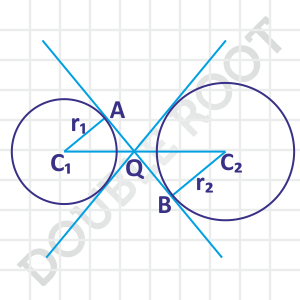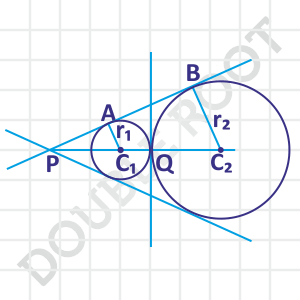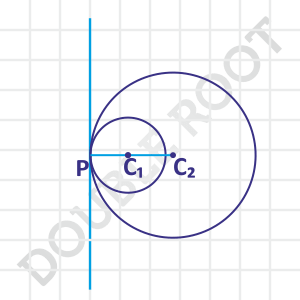This lesson will focus on finding the equations of common tangents to two circles.
The methods are quite similar for all the cases (except the last) covered in the previous lesson. Let’s begin then.
Circles lying outside each other
Let’s draw the direct common tangents, which intersect and P.

Now the idea here is to somehow find the coordinates of P, and use our existing knowledge of finding equations of tangents from an external point to a circle.
I’ll draw some lines to help me.

Now observe that the triangles PC1A and PC2B are similar. That means, PC1/PC2 = r1/r2. In other words, P divides C1C2 in the ratio r1 : r2 externally. And using the section formula, we can easily obtain the coordinates of P.
Next, using the method discussed here, we can obtain the equation of the tangents from P to any of the circles. Neat!
Let’s move on to the transverse common tangents.

In this case, the triangles QC1A and QC2B are similar, which means that QC1/QC2 = r1/r2. That is, Q also divides C1C2 in the ratio r1 : r2, but this time internally.
And we’ll use the section formula again to obtain the coordinates of Q.
Finally, we’ll find the equation of the tangents from the external point Q to any of the circles.
Circles touching each other externally

In this case, the method for the direct common tangents remains the same. To find the equation of the tangent at the point of contact, we’ll use the point-slope form. To find the point, we’ll use the fact that it divides C1C2 in the ratio r1 : r2, internally. To find the slope we’ll use the fact that this tangent is perpendicular to the line joining the centres.
Circles intersecting at two points
Same here. We’ll use the method in the first case for the direct common tangents.

Circles touching each other internally

The tangent here is perpendicular to the line joining the centres, and passes through the point which divides C1C2 in the ratio r1 : r2 externally.
Using the point-slope form again, we can obtain its equation easily.
And that’ll be all for this lesson. I won’t establish any formulas / expressions here, but will directly illustrate all the cases in the next lesson. You needn’t remember any formulas too, just remember the methods.
P.S. I’ll cover another much easier method in a later lesson to find the equation of the vertical tangents in the cases where the circles touch. Stay tuned!
P.P.S There’s something which I didn’t tell you. What if the direct common tangents do not intersect? How will you find the equations then?